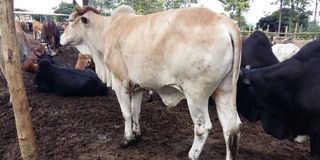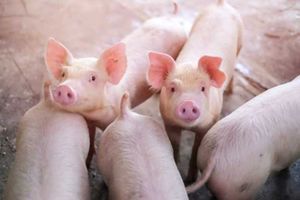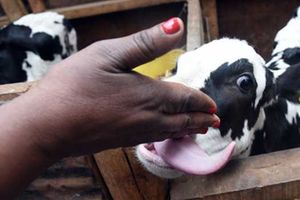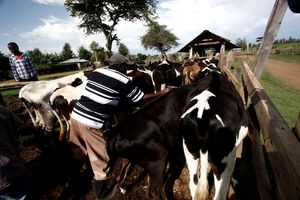
A cow after 90 days of Fattening and finishing at a feedlot. It is good to observe the feeding behaviour of the cattle in a feedlot, especially when using unground hay.
I have narrated about the beef feedlot. I and another consultant assisted my client to set up one in Athi River, Machakos County, starting construction on March 10. Three months down the line, it was completed and stocked.
Some people, also interested in beef feedlot farming, came to the farm last week and were shocked to see that despite the animals being in the pen permanently and eating to their fill, there was barely any manure.
A visitor even praised the employees for keeping the pens clean. He asked if dung removal was daily. The visitor was shocked to hear that the pens are never cleaned until the cows are sold after 90 to 120 days from the date of entry. He loudly wondered why there was no manure.
I told the visitor that feedlot cattle are given high quality well-formulated diet. Most of the feed is digested and absorbed into the body, leaving little to be voided as dung.
If you find a feedlot cow shedding a lot of dung, then you should revisit your feed preparation and the quality and quantity of ingredients. The other thing is feedlot cattle usually produce hard faeces. Soft or liquid faeces indicate that the animals may be feeding on too much concentrate. This happens most when feed mixing is manual or the hay is fed unground or cut in long pieces.
It is good to observe the feeding behaviour of the cattle in a feedlot, especially when using unground hay or hay cut into long pieces. Such hay does not mix well with the concentrate and the animals tend to eat the concentrate first before eating the hay. Such mixing is also not recommended because some animals tend to over-eat concentrate and get indigestion and reduction of weight gain.
There is also increased commotion during feeding because stronger animals keep changing positions to get to the place with more concentrate in the trough. There is increased competition for food, hence more fighting among the animals.
When the animals came, I vaccinated them against foot and mouth disease (FMD), lumpy skin disease (LSD), anthrax, black quarter and Rift Valley fever (RVF) on June 3.
I left out one vaccine, contagious bovine pleuropneumonia (CBPP), which was not available at the time. But even if it was available, I would have vaccinated it later as the vaccine load would have been too heavy on every animal.
The vaccination had gone well and no animal had reacted negatively. Such reactions are rare but they do happen. I have seen at least six cases of vaccine reactions in cattle during my 37 years of practice. All responded well to treatment and no death or damage was observed.
The vaccines mentioned are supposed to be given to cattle routinely once a year, except FMD and CBPP that are given two times. If the country did that routinely, vaccinating at least 70 per cent of the nation’s cattle and goats, we would become free of the diseases in five to 10 years.
I went back to the farm this week to review the performance of the animals and vaccinate them against CBPP. I noted that the animals were doing well one month after entering the feedlock.
They have generally been increasing their weight as shown from the weekly weighing and body condition. They had come with an average age of 190 kilos but this week, they had attained a herd average of 200kg. The entry weight was much lower than the recommended due to unavailability of suitable animals in the market as explained in one of my earlier articles.
When the animals got into the crush for vaccination, I noted some development that raised concern. Six had raised hairs on multiple areas of the skin. I palpated the affected areas and felt dry hard skin appearing as pinhead formations.
It is recommended that animals first be examined before vaccination to ensure they are in good health. Sick animals should not be vaccinated but be treated and vaccinated later once they recover.
I squeezed the raised areas and they caused no pain to the animals. I informed the owner and the workers that we had had a close shave with one of the deadly illnesses – lumpy skin disease.
My findings confirmed that the affected animals had been infected with LSD sometime after the vaccination I had done earlier but they had managed to fight the disease and terminate the virus before it could cause severe disease.
Deadly lung disease
The findings could only mean that the animals had been vaccinated against LSD at source, giving them immunity or they could have been infected when the vaccine I had given had already produced a protective level of immunity.
I informed the farm owner that it did not matter which immunity had protected his cows. The issue was that we had vaccinated the animals and they had stopped a disease from being full-blown two weeks later. It takes two to three weeks for the body to generate appreciable immunity.
Through the cases of mild LSD I observed, the owner and the employees now understood the importance of vaccinating animals as soon as they arrive on the farm. The good thing with vaccination is that the animals are in no danger even if they had been vaccinated at their place of origin.
After confirming the health of all the animals, I quickly vaccinated them against CBPP.
This is a deadly lung disease of cattle and goats that causes difficulty in breathing and kills most of the affected animals.









